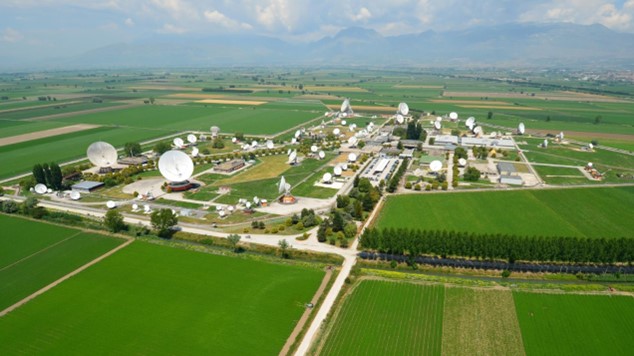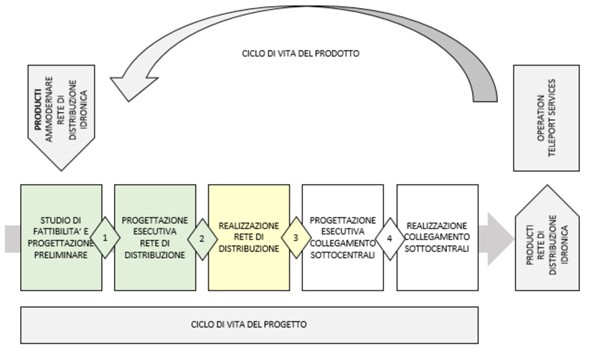AUTORE: Tommaso Baroncelli
TUTOR: Ing. Giovanni Franchi
MASTER: Contract and Project Management a.a. 2021/2022
La tesi ripercorre in chiave di corretto Project Management le attività di progetto volte all’ammodernamento della rete di distribuzione idronica attualmente a servizio del Centro Spaziale del Fucino “Piero Fanti”, Teleporto situato ad Ortucchio (AQ), di proprietà Telespazio Spa, che con 40 ettari ca. e 170 antenne costituisce il più grande Teleporto al mondo per usi civili.
La rete di distribuzione idronica, realizzata ed ampliata a partire dagli anni 70, rappresenta una delle infrastrutture principali del Teleporto, distribuendo acqua refrigerata per il condizionamento della maggior parte delle utenze distribuite per il Centro Spaziale. Date le condizioni generali dell’impianto, e data la criticità dello stesso all’interno del Teleporto, si è reso necessario un intervento di ammodernamento dell’impianto stesso, volto a superare l’obsolescenza delle tubazioni, coibentazioni e delle valvole che lo compongono.
Il progetto si è sviluppato in diverse fasi successive, a partire da uno studio di fattibilità che ha individuato il nuovo modello di impianto da implementare, fino alle fasi di progettazione esecutiva e costruzione dell’opera. La fase di cantierizzazione dell’opera è in fase di preparazione, con inizio previsto per aprile ’23.
La prima fase del progetto è volta a determinare il modello funzionale di riferimento da perseguire nelle successive fasi di progettazione esecutiva e di realizzazione dell’opera. In tale fase vengono eseguiti:
- rilievi planimetrici, per determinare la configurazione allo stato di fatto della linea di distribuzione idronica
- studi di fattibilità, nel quale vengono messi a confronto diversi modelli operativi al fine di determinare l’ottimo in termini di funzionalità, affidabilità, ridondanza ed espandibilità
- progettazione definitiva, in cui vengono prodotti tutti gli elaborati progettuali funzionali alle successive fasi del progetto.
La seconda fase è dedicata alla progettazione esecutiva della nuova linea di distribuzione, nel quale vengono prodotti tutti gli elaborati costruttivi necessari alla cantierizzazione dell’opera, vengono definite le tempistiche ed i costi associati all’intervento e vengono individuate le criticità operative durante l’esecuzione dell’opera. Le attività di progettazione sono eseguite da una società esterna, aggiudicataria della gara di appalto, e vengono settimanalmente monitorate da parte del Responsabile di Progetto della Telespazio Spa, coadiuvato da un professionista esterno incaricato al ruolo di Direttore dei Lavori.
La terza fase del progetto, ancora in attesa di iniziare, è dedicata invece alla realizzazione della linea di distribuzione idronica come approvata in fase di progettazione esecutiva.
Il lavoro del presente documento produce un confronto diretto tra i 49 processi di Project Management previsti dal Body of Knowledge e i processi realmente utilizzati nel corso dell’esecuzione delle diverse fasi del progetto.
Vengono in particolare affrontate le tematiche di programmazione e gestione delle attività di studi preliminari, progettazione e di cantiere, evidenziando gli strumenti adottati per la pianificazione delle attività lavorative ed il controllo durante l’esecuzione delle stesse. Il processo viene reiterato per tutte le fasi del progetto, che vengono analizzate distintamente come singolo progetto in analogia a quanto espletato nel caso reale.
Per ciascuna fase tutti i processi vengono analizzati puntualmente, andando ad individuare parallelismi ed eventuali divergenze tra il processo applicato ed il processo teorico.
Entrando nel dettaglio, i processi appartenenti ai gruppi di avvio e pianificazione sono stati analizzati per tutte e tre le fasi del progetto e per ciascuna delle aree delle conoscenze applicabili (ad esempio nelle fasi di progettazione la voce “Gestione degli approvvigionamenti” non è applicabile), andando a dettagliare le procedure e output per ciascuno di essi. La stessa procedura è stata applicata per i gruppi di processo dell’esecuzione, monitoraggio e controllo e chiusura alle prime due fasi del progetto. La terza fase, quelle dedicata alla realizzazione della linea, è ancora in fase di inizializzazione (la cantierizzazione dell’opera è prevista per aprile ’23).
Il risultato che ne consegue è una descrizione accurata di tutti i processi che hanno caratterizzato il progetto nel caso reale, i documenti utilizzati, le procedure applicate, consentendolo di portarlo a termine entro i vincoli di requisito, di costo e di tempo previsti.
FOR INTERNATIONAL STUDENTS:
The thesis analyses the project activities realized for the upgrade of the hydronic distribution system currently serving the Fucino Space Center “Piero Fanti”, Teleport located in Ortucchio (AQ), owned by Telespazio Spa, which constitutes the largest Teleport in the world for civilian use with 40 hectares approx. and 170 antennas.
The hydronic distribution system, built and expanded starting in the 1970s, represents one of the main infrastructures of the Teleport, distributing chilled water for conditioning most of the users distributed for the Space Centre. Given the general conditions of the plant, and given the importance of the infrastructure within the Teleport, it was necessary to modernize the hydronic system, in order to overcome the obsolescence of the pipes, insulation and valves of the system itself.
The project has been developed in several sequential phases, starting from a feasibility study, which identified the new plant model to be implemented, up to the executive design, and construction phases of the work. The construction site phase is in preparation, and the start is scheduled for April ’23.
The first phase of the project aims to define the functional model to be used along the following phases as per executive design and realization of the infrastructure. During this step the following items are defined:
- Planimetric surveys in order to define the current distribution of the hydronic distribution system
- Feasibility analysis, where different functional models are compared in order to define the best solution in terms of functionality, reliability, redundancy and expandability
- Preliminary design, where all the technical drawings and documents are produced in order to prosecute the following steps of the projects
The second phase of the project is focused on the executive design of the infrastructure. All the final technical drawings and documents are produced, time and cost are defined and critical aspects of the intervention are highlighted. Design activities are developed by an external company, as per public bid, and are weekly monitored from the Project Manager of the Telespazio Spa supported by an external engineer in the role of construction manager.
The third and last phase of the project, not started yet, is focused on the realization of the hydronic distribution system as per executive design (phase 02).
The work produces a direct comparison between the 49 Project Management processes envisaged by the Body of Knowledge and the processes actually used during the execution of the various phases of the project.
In particular, it is analyzed the planning and management of preliminary studies, design and construction site activities, highlighting the tools and method adopted for planning work activities and controlling them during their execution. The process is repeated for all phases of the project, which are analyzed separately as a single project in analogy to what was carried out in the real case.
For each phase all the management processes are analyzed, also trying to highlight parallelism and difference from the applied process and the theoretical one.
In detail, start and planning management process are analyzed for all the three phases and for all the applicable knowledge area (for example during the design phase the “Supply management” is not applicable). In this process procedure and output of each process are described and reported. The same procedure is applied for the execution, monitor and control and closing of the first two phase of the project. The beginning of the third phase, dedicated to the realization of the infrastructure, is foreseen for April ’23).
The result of this analysis is a description of the processes used along the real management of the project, the produced document, the procedure, which allowed the Project Manager to reach the goal of the project within the expected requirements, cost and schedule.


